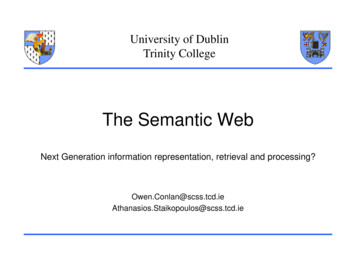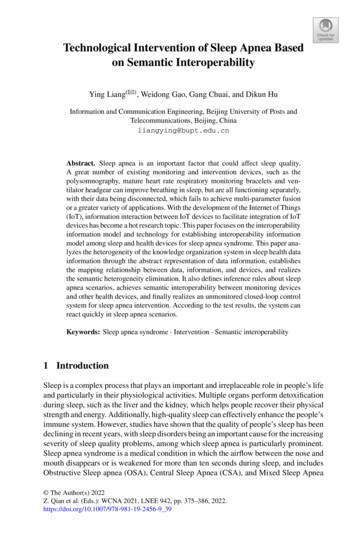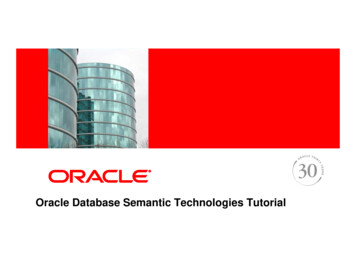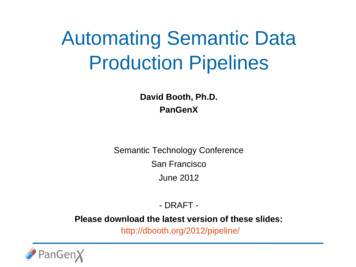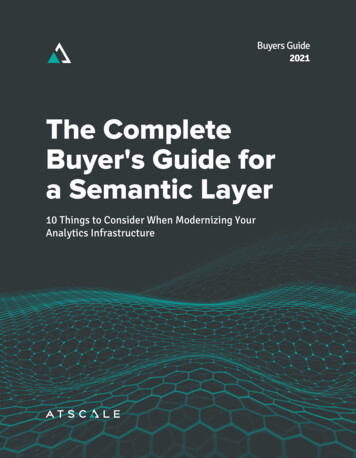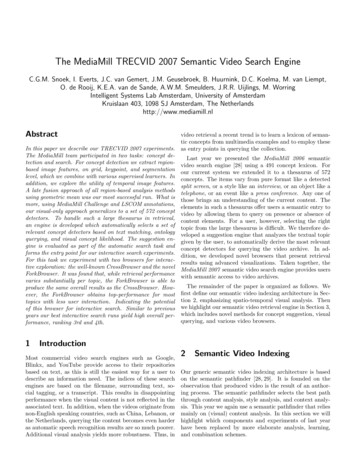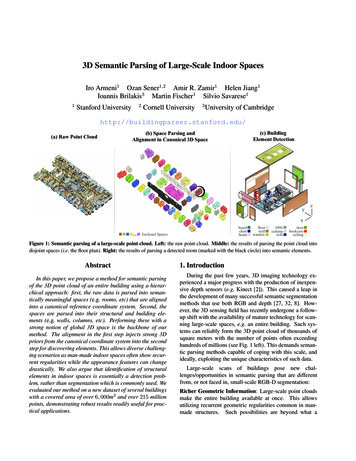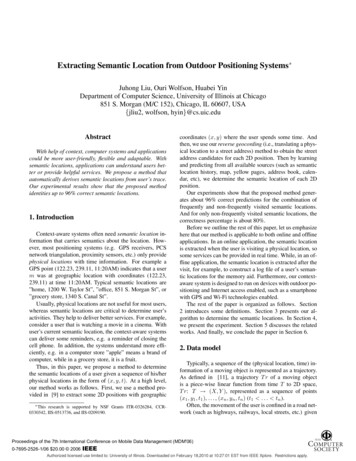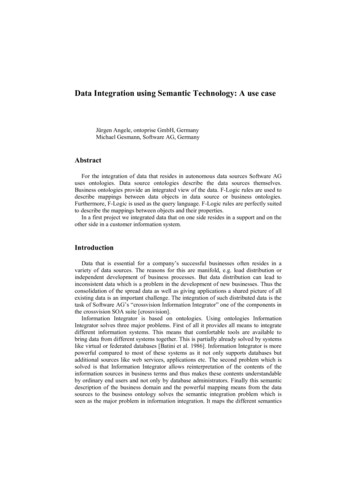
Transcription
Data Integration using Semantic Technology: A use caseJürgen Angele, ontoprise GmbH, GermanyMichael Gesmann, Software AG, GermanyAbstractFor the integration of data that resides in autonomous data sources Software AGuses ontologies. Data source ontologies describe the data sources themselves.Business ontologies provide an integrated view of the data. F-Logic rules are used todescribe mappings between data objects in data source or business ontologies.Furthermore, F-Logic is used as the query language. F-Logic rules are perfectly suitedto describe the mappings between objects and their properties.In a first project we integrated data that on one side resides in a support and on theother side in a customer information system.IntroductionData that is essential for a company’s successful businesses often resides in avariety of data sources. The reasons for this are manifold, e.g. load distribution orindependent development of business processes. But data distribution can lead toinconsistent data which is a problem in the development of new businesses. Thus theconsolidation of the spread data as well as giving applications a shared picture of allexisting data is an important challenge. The integration of such distributed data is thetask of Software AG’s “crossvision Information Integrator” one of the components inthe crossvision SOA suite [crossvision].Information Integrator is based on ontologies. Using ontologies InformationIntegrator solves three major problems. First of all it provides all means to integratedifferent information systems. This means that comfortable tools are available tobring data from different systems together. This is partially already solved by systemslike virtual or federated databases [Batini et al. 1986]. Information Integrator is morepowerful compared to most of these systems as it not only supports databases butadditional sources like web services, applications etc. The second problem which issolved is that Information Integrator allows reinterpretation of the contents of theinformation sources in business terms and thus makes these contents understandableby ordinary end users and not only by database administrators. Finally this semanticdescription of the business domain and the powerful mapping means from the datasources to the business ontology solves the semantic integration problem which isseen as the major problem in information integration. It maps the different semantics
within the information sources to the shared conceptualization in the businessontology.Within Software AG Information Integrator was used for a first project CustomerInformation Gateway (CIG) whose mission was to integrate data that on one sideresides in a support information system and on the other side is stored in a customerinformation system.Conceptual LayeringConceptually Information Integrator arranges information and the access toinformation on four different layers (cf. fig 1): The bottom layer represents different data sources which contain or deliver theraw information which is semantically reinterpreted on an upper layer viz.ontologies. Currently relational databases, Adabas databases and web services aresupported. The second layer assigns a so called “data-source ontology” to each of the datasources. These “data-source ontologies” reflect only database or WSDL schemasof the data sources in terms of ontologies and can be created automatically. Thusthey are not real ontologies as they do not represent a shared conceptualization ofa domain. The third layer represents the business ontology using terminology relevant tobusiness users. This ontology is a real ontology, i.e. it describes the sharedconceptualization of the domain at hand. It is a reinterpretation of the datadescribed in the data-source ontologies and thus gives these data a sharedsemantics. As a consequence a mental effort is necessary for this reengineering ofthe data source contents which cannot be done automatically. On a fourth layer views to the business ontologies are defined. Basically theseviews query the integration ontology for the needed information. Exposed asWeb services they can be consumed by portals, composite applications, businessprocesses or other SOA components.The mappings between the data-sources and the source ontologies are createdautomatically, the mappings between the ontologies are manually engineered and theviews are manually defined queries. Mappings provide ways to restructureinformation, to rename information or to transform values. Up to now, we do notconsider and do not plan to consider approaches which try to automatically derivesuch mappings [Rahm and Bernstein 2001].This arrangement of information on different layers and the conceptualrepresentation in ontologies and the mediation between the different models bymappings provide various advantages: The reengineered information in the business ontology is a value on its own. Therepresentation as an ontology is a medium to be discussed easily by non-ITexperts. Thus aggregating data from multiple systems this business ontologyprovides a single view on relevant information in the user’s terminology.
viewsbusiness ontologymanual mappingsdata source ontologiesautomatical mappingsdata sourcesFig 1. Conceptual Layering of Ontologies It is easy to integrate a new data source with a new data schema into the system.It is sufficient to create a mapping between the corresponding source ontologyand the integration ontology and thus does not require any programming knowhow; pure modelling is sufficient. The mediation of information between data sources and applications viaontologies clearly separate both. Thus changes in the data source schemas do notaffect changes in the applications, but only affect changes in the mediation layer,i.e. in the mappings. This conceptual structure strongly increases business agility. It makes it very easyto restructure information and thus to react on changing requirements. Only thebusiness ontology and the mappings have to be modified. Thus it minimizes theimpact of change, eases maintenance and allows for rapid implementation of newstrategies Ontologies have powerful means to represent additional knowledge on anabstract level. So for instance by rules the business ontology may be extended byadditional knowledge about the domain. Thus the business ontology is areinterpretation of the data as well as a way to represent complex knowledgeinterrelating these data. So business rules are directly captured in the informationmodel.Tool Support / ArchitectureThe crossvision Information Integrator provides a full fledged tool environment fordefining models, for mappings between these models and for running queries (cf. fig2). IntegratorStudio is an ontology engineering environment based on OntoStudioTM.It allows for defining classes with properties, instances of these classes and rules.Import capabilities generate “source ontologies” from underlying data sources. A
powerful mapping tool allows users to interactively define mappings betweenontologies by graphical and form based means (cf. fig. 3). Rules may be defined withgraphical diagrams. IntegratorStudio supports F-Logic [Kifer, Lausen, Wu 1995],RDF(S), OWL for import and export. Queries which define the mentioned views canbe generated and may be exported as web services.InputIntegrator StudioRuntimeBusiness ModelDynamic QueriesUser accessSQLDesign& MappingQueryBuildingWebServicePhysical ModelImportMetadataDeploySemanticServerSOA Registry/RepositoryRealtime accessFig. 2 Architecture of the crossvision Information IntegratorSemanticServer, the reasoning system, provides means for efficient reasoning in FLogic. SemanticServer performs a mixture of forward and backward chaining basedon the dynamic filtering algorithm [Kifer, Lozinskii 1986] to compute (the smallestpossible) subset of the model for answering the query. The semantics for a set of FLogic statements is the well-founded semantics [Van Gelder, Ross, Schlipf 1991].Meta data like ontologies, their mappings, web service descriptions and metainformation about data sources are stored in the CentraSite repository. Also,IntegratorStudio stores information about exported web services in CentraSite. Duringstartup the inference engine SemanticServer which is based on OntoBrokerTM loadsthe ontologies from the repository and then waits for queries from the exported webservices. These queries are evaluated by SemanticServer and are online translated intocalls to access connected data sources.Thus SemanticServer represents the run-time engine, IntegratorStudio themodelling environment and CentraSite the meta data repository. SemanticServer isalso integrated into IntegratorStudio thus enabling immediate execution of queries tothe ontologies.
Fig. 3 Mapping Tool in crossvision Information IntegratorUse Case: Customer Information GatewayWithin Software AG the Information Integrator was used for a first project whosemission was to integrate data that on one side resides in a support and on the otherside in a customer information system. The support system stores customers, theircontact information and active or closed support requests in an SQL server. Thecustomer system provides information about clients, contracts etc. in an Adabasdatabase. The integrated data view is exposed in a browser based application tovarious parties inside the company, for instance to support engineers.For illustration purposes we first sketch a very simplified excerpt of imported dataand the business ontology. Throughout the following examples we use F-Logicsyntax.First of all there are two classes which have been generated by the mentionedautomatic mapping from Adabas files:F151CONTRACT [ F151AA string; F151AE date ].F87CLIENT [ F87AA number; F87AB string; F87AC string ].The cryptic names reflect the internal structure of Adabas files. The names“CONTRACT” and “CLIENT” have been specified by the user during the mappingprocess. Currently, the semantics of properties is only application knowledge.Furthermore, we consider two tables from the SQL database. The generated classesare:CUSTOMER [ id number; name string; addr string ].CASE [ caseId number; customerId string; forCustomer CUSTOMER ].The business ontology shall contain three classes:Customer [name string; address string ].SupportRequest [ id number; status string; issuedBy Customer ].Contract[contractId string;contractEnd date;contracEndFormatted string].
In the sequel we present some examples on how we used rules within ourontologies and derive some requirements and use cases for rule languages to be usedin such a project.Data source importIn Information Integrator user-defined built-in predicates implement access toexternal data sources. In the sequel we abstract from a concrete syntax of these builtin predicates. Instead we illustrate this by a generic predicate “dataAccess”:dataAccess(ci, “tablename”, “rowid1”, X, “rowid2”, Y, )where ci describes all parameters that are needed to call the data source,tablename, rowid1, rowid2 are names of some database tables or table columns. X, Yare the names of variables which are to be bound by the built-in predicate.In our example there are rules for ever class in the source ontologies which importdata from external data sources. Two of these rules are:FORALL X, Y c(“F151”,X) : F151CONTRACT [ F151AA X; F151AE Y] dataAccess(ci, “F151”, “AA”, X, “AE”, Y).FORALL X, Y c(“CASE”, X) : CASE[caseId X; customerId Y] dataAccess(ci, ”CASE”, “caseId”, X,“customerId”, Y) ].Every functional model needs to describe relations between objects. Objectproperties are used to express these relationships. Object identifiers serve as objectproperty values which are similar to foreign keys in relational databases. The foreignkey definitions in a schema descriptions are used to generate object properties insource ontologies:FORALL X, Y X[forCustomer c(“CUSTOMER”, Y)] X:CASE[customerId Y].Source to Business model mappingsIt is very easy to define that an object in the data source model is also an object inthe business model. Similarly mappings between properties in both models can beexpressed. The following example combines both mappings for contract objects:FORALL X, Y, Z X : Contract [ contractId Y; contractEnd Z ] X : F151CONTRACT [ F151AA Y; F151AE Z ].If the underlying data from the external sources contains such information, it isalso easily possible to describe that two objects are the same. For example a client inthe customer information system and a customer in the support information systemrepresent the same object, if these have the same name and address. Please note,surrogate values as unique keys are typically not viable object identifiers acrossindependent data sources. Therefore, we need to identify new identifiers:FORALL X, Y, Z c(”Customer”, Y, Z) : Customer [ name Y ; address Z ] X : CUSTOMER [ name Y; addr Z ].FORALL X, Y, Z c(“Customer”, Y, Z):Customer[ name Y; address Z] X:F87CLIENT[F87AB Y; F87AC Z].Often in independent data sources similar data can be encoded in a different ways,e.g. different data types or type systems. Then functions are needed which implementtransformations:FORALL X, Y Y[ contractEndFormatted X ] EXISTS Z (Y : Contract [ contractEnd Z ] and date2string(Z, X)).where date2string() transforms a date from one format into another one.Also, object properties need to be mapped to the business ontology:
FORALL X, Y, Z1, Z2 X : SupportRequest [ issuedBy c(“Customer”,Z1,Z2) ] X : CASE [ forCustomer Y ]and c(“CUSTOMER”,Y) [ name Z1; addr Z2 ].The inverse reference is also often needed. But because the foreign key constraintin SQL systems does not provide a name for the inverse relation this is currentlypostponed to application development. N:M relationships, implemented by two 1:Nforeign key relations in SQL systems, could also be expressed directly.All these simple types of mappings are essential for specification of businessontologies on top of data source or other business ontologies. Most of them can bedescribed in the Information Integrator with graphical means, i.e. developers do notneed to see the F-Logic syntax.QueriesTo lower investments for learning new languages and to avoid impedancemismatches rule- and query-language should be the same. Information Integrator usesF-Logic for ontology definitions and as the query language. But, queries in the dataintegration scenario are much like database queries. Primarily we want to retrievedata. We are not so much interested in explanations or in information about whichvariable bindings lead to a result. This focus on data access requirements sometimesleads to quite complex query formulations. One example is different handling of notexisting values (null values) in SQL and F-Logic. Another example are user definedprojections. In order to minimize the number of expensive interactions between clientand server we database folks tend to create queries which return complex structuredresults. Object relations should be contained in the result. E.g. for one customerhaving multiple contracts each having contract items, then the query result shouldcontain the information which contract item belongs to which contract within a singleresult per customer.PerformanceBecause the integrated view is used in an application where e.g. support engineersexpect fast answers for even complex queries while talking to a customer, theperformance of the rule and query processing is extremely important. In some casesresponse times in the range of a few seconds are not accepted. In our first project a lotof effort was spent to improve the responsiveness of the system. Problems thatshowed up here are very similar to query optimization problems in database systems.Just for illustration we give two examples. First, the data source mappings asshown above always addressed only a single database table or file. However, a systemthat implements access to external data sources only via such single-table access ruleswill not achieve sufficient performance. Instead access operations should use the datasource’s query capabilities like join-operations. As a second example, the rule enginesometimes first retrieved all data from a table and then continued with the evaluationof filters. Instead, filters need to be identified first and given to the query which readsdata from the database.
Summary and OutlookA data model in Information Integrator consists of ontologies. Data source modelsdescribe the structure of data that resides in external data sources. Business ontologiesprovide a conceptualization of business entities. F-Logic rules are used to definemappings between ontologies. Furthermore, rules are the first choice to expresssemantics that is not immediately available within the data and otherwise had to beimplemented in queries or applications. F-Logic is also used as the query language.With the exception of mapping rules the business ontology of our first project doesnot contain many other rules. Access to information in these models is more dataretrieval and not so much knowledge inference. Much effort during this project wasspent on performance improvements.With an increasing number of web services where some simply expose data, wealso need to support data integration for such web services in our crossvision SOAsuite. We are currently working on the mapping of web services and their structuredXML data to source ontologies.The crossvision Information Integrator based on ontoprise OntoStudioTM andOntobrokerTM is the first step for Software AG in the field of semantic technologies.Recently we joined various EU research projects like NeOn (Lifecycle Support forNetworked Ontologies) [NEON], “Business Register Interoperability ThroughoutEurope” and “SemanticGov: Services for Public Administration” [SemanticGov]. Allthese projects address concrete business cases. With our participation in these projectswe intend to achieve deeper understanding of needs for adequate tooling and runtimesystems when using semantics technologies for data integration. On the other hand wewill contribute our knowledge about data-intensive processing.References[Batini et al. 1986] Batini C., Lenzerini M., Navathe S.B. A Comparative Analysis ofMethodologies for Database Schema Integration. ACM Computing Surveys Vol. 18(4):323364, 1986[Belkin 1980] N.J. Belkin. Anomalous states of knowledge as a basis for information retrieval.The Canadian Journal of Information Science, 5:133--143, 1980.[crossvision] http://www.softwareag.com/crossvision[Kifer, Lausen, Wu 1995]. Logical foundations of object-oriented and framebased languages.Journal of the ACM, 42; (1995) 741–843[Kifer, Lozinskii 1986]. A framework for an efficient implementation of deductive databases.In Proceedings of the 6th Advanced Database Symposium, Tokyo, August (1986) 109–116[Jaro 1989] M. A. Jaro. Advances in record-linkage methodology as applied to matching the1985 census of Tampa, Florida. Journal of the American Statistical Association 84:414–420,1989.[Jaro 1995] M.A. Jaro. Probabilistic linkage of large public health data files (disc: P687-689).Statistics in Medicine 14:491–498, 1995.[NEON] http://www.neon-project.org[Rahm and Bernstein 2001] E. Rahm, P. Bernstein. A survey of approaches to automaticschema matching, VLDB Journal 10(4):334-350, 2001[SemanticGov] http://www.semantic-gov.org
[Van Gelder, Ross, Schlipf 1991]. The well-founded semantics for general logic programs.Journal of the ACM, 38(3); July (1991) 620–650
For the integration of data that resides in autonomous data sources Software AG uses ontologies. Data source ontologies describe the data sources themselves. Business ontologies provide an integrated view of the data. F-Logic rules are used to describe mappings between data objects in data source or business ontologies.
